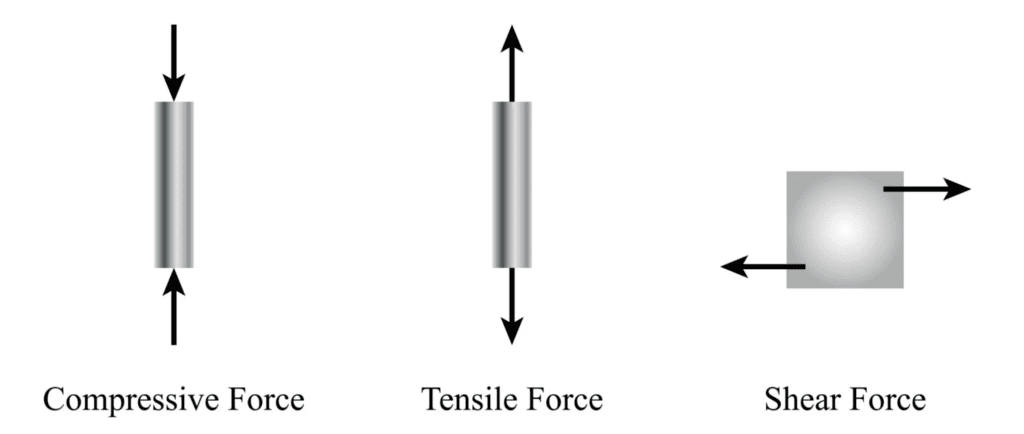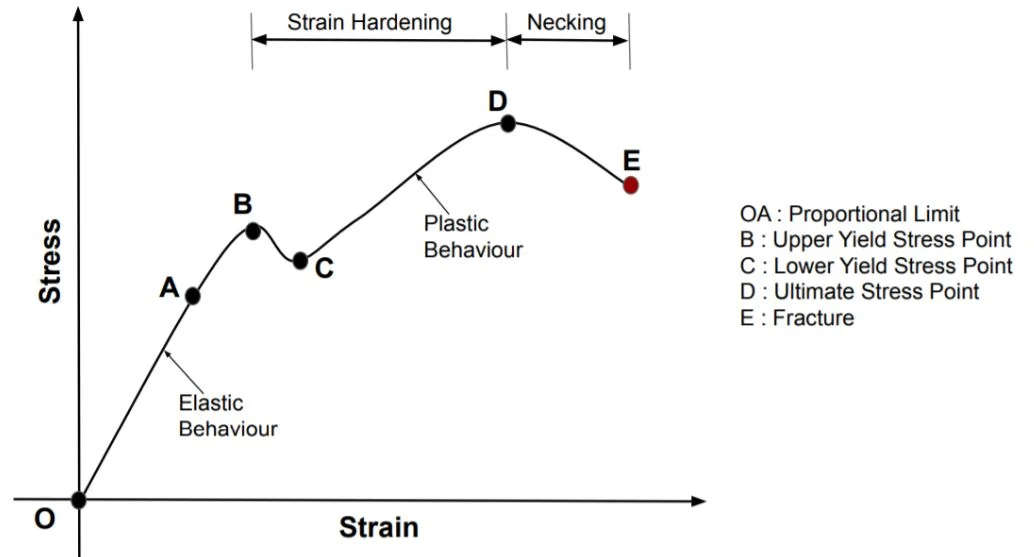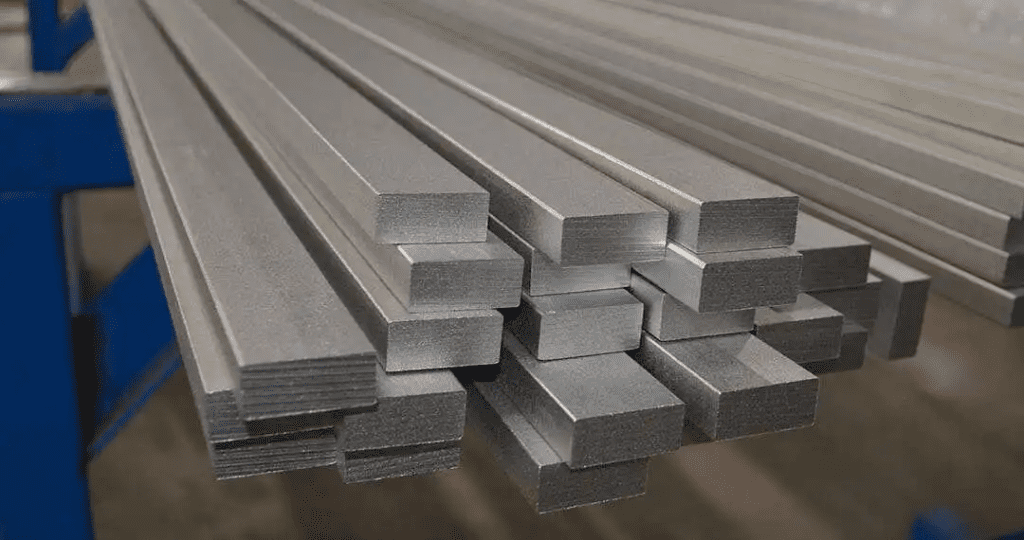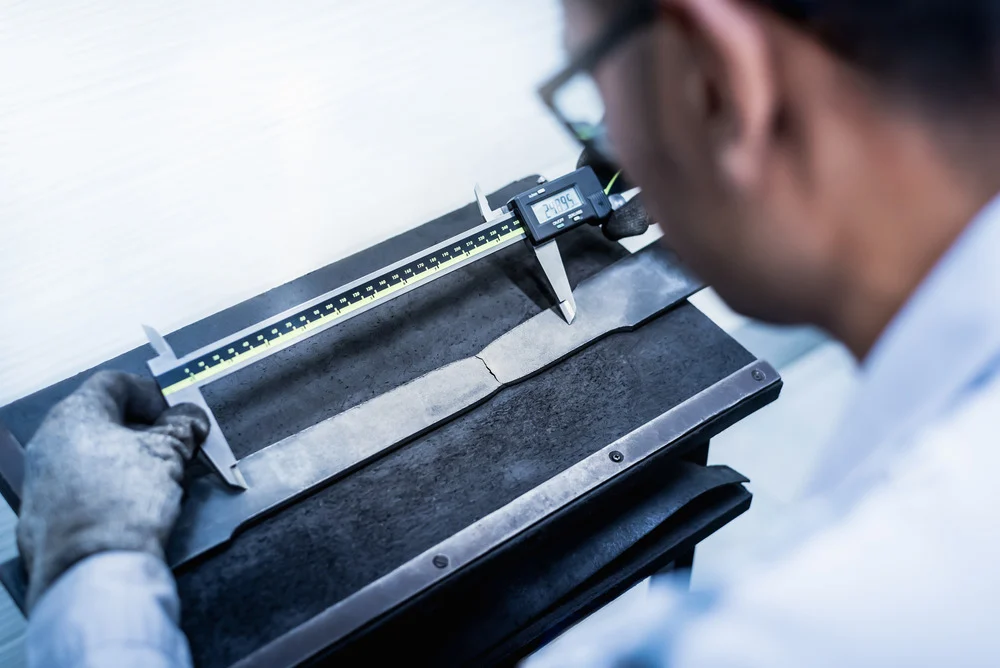It’s important to analyze the different mechanical properties of any metal before considering its application for a project.
In this regard, yield strength vs tensile strength are two of the most important properties to consider, as they offer deep insight into a material’s ability to withstand stress with and without going into permanent deformation.
Below, we briefly describe tensile strength vs. yield strength and how these values can affect the structural integrity and fabrication of different metals.
Yield Strength vs. Tensile Strength
Let’s dive a little deeper into the differences between tensile strength and yield strength and the effects they have on metals.
Tensile Strength

The maximum tensile stress that a material can handle before rupturing is known as its tensile strength. Beyond this limit, the material develops necking and breaks into pieces.
While talking about tensile strength, a material’s ductility may also be of interest. A ductile material can deform more than brittle materials before it fractures.
Yield Strength
Yield strength represents the maximum stress a material can handle without going through any plastic deformation. This is represented as the yield point on the stress-strain curve, as shown below.

As you can see from the graph, for small strains, the deformation is within the elastic limit. It continues until the force reaches the proportional limit (point A) and reverses if the load is removed before that point.
From point A to B, small stress generates a large strain—the first deviation of the curve from linearity. If the stress is more severe, the original shape is partially recovered.
After the upper yield limit (B), the material loses its elasticity and enters the zone of plasticity. The level of stress that causes appreciable plastic deformation is called yield stress. Further increase in the deforming force ultimately leads to material failure.
The nature of permanent deformation is dependent on the material type.
For some ductile materials, such as copper and aluminum, it is impossible to acknowledge an exact yield point, as the metal can stretch over a high-stress value.
In such cases, drawing a parallel line to the initial linear portion of the stress-strain curve, but offset from it by 0.2%, gives us the maximum stress value, also known as the proof of stress.
The table below compares tensile strength vs. yield strength, which is applicable for any metal in general.
| Tensile strength | Yield strength |
|
|
|
Buy Certified High-Quality Metals for Industrial Solutions |
||
|
New Aluminum |
New Steel |
New Stainless Steel |
 |
 |
 |
| Reliable supply: Consistent, certified aluminum stock you can trust. High-quality material: Superior-grade aluminum for precision needs. Custom cuts: Accurate cuts down to thousandths of an inch. |
Durability and strength: Reliable for projects needing long-lasting, tough materials. Cost-effective: Quality steel that offers strength without breaking the bank. Custom cutting: Precise cuts tailored to exact needs with top-tier cutting tools. |
Sustainability: Highly eco-friendly as the most recyclable metal on earth. High durability: Resistant to corrosion and wear, ensuring long-lasting performance. Custom precision cuts: Tailored to your specifications with quick, accurate results. |
The Importance of Tensile Strength and Yield Strength in Metals

Analyzing the tensile strength vs. yield strength of a metal becomes essential under the following scenarios.
Acknowledging Structural Integrity
The yield strength and tensile strength of a metal decide its areas of application. In the case of larger projects, such as in the aerospace or construction industries, these factors are a matter of life or death.
Designers ensure that the maximum stress never reaches the yield strength of the metal used. On the other hand, the ultimate tensile strength tells us the maximum force the metal structure can handle before it collapses.
Metal Fabrication
Metals are checked for strength and ductility throughout different phases of a product life cycle. The upper load limit (yield strength) describes a metal’s behavior during various fabrication processes, including pressing, rolling, and forging.
The ultimate tensile strength sets the maximum load limit for the product beyond which it may lose any important property due to permanent deformation or changes to the metal’s crystal structure.
Testing for Super Alloys
It is easy to use yield strength as one of the parameters to test a superalloy. Unlike brittle materials or a general metal alloy, a superalloy displays high yield strength even at high temperatures. Thus, they are preferred for high-strength applications.
This is particularly relevant when conducting a tensile test on such superalloys. During a tensile test, the properties of the material are observed as the specimen is subjected to increasing amounts of load, providing valuable insights into the tensile and yield strength at various stress levels.
Tensile Strength vs. Yield Strength of Different Metals
Let’s compare the tensile strength and yield strength of some commonly used metals.
| Metal | Tensile Strength (MPa) | Yield Strength (MPa) |
| Aluminum 6061 T6 | 310 | 276 |
| Aluminum 5052 H32 | 227 | 193 |
| Brass | 250 | 95 |
| Copper | 220 | 70 |
| Structural steel (ASTM-A36) | 400 | 250 |
| Titanium alloy | 900 | 730 |
| A106 Carbon steel pipe Grade C | 485 | 275 |
| Invar | 400 | 230 |
| Tungsten | 980 | 750 |
| Vanadium | 800 | 776 |
Metals with high yield strength and tensile strength come with machining challenges. For instance, tungsten has the highest tensile strength of any other metal. However, it becomes very brittle at room temperature and is subjected to unwanted chipping.
This brittleness occurs when the material begins to undergo plastic deformation after being subjected to high applied stress. Special heat treatment methods must be used to improve the material’s resistance to deformation and create a conducive machining environment.
Having an experienced metal service provider by your side can help you overcome all these hassles with ease, as they know how to ensure the maximum stress applied is within safe limits to maintain the material’s structural integrity.
High-Quality Metal Services From a Reputable Supplier
At Industrial Metal Service, we have more than two decades of experience offering a wide range of new and verified remnant metals—including stainless steel, aluminum, titanium, and more—to our customers in the San Francisco Bay Area and beyond.
We understand the importance of tensile strength measurements and ensuring that the material you receive can withstand the maximum stress during its application without unnecessary plastic deformation.
We’ve earned our reputation as a reliable and trustworthy metal supplier and service provider, and we want to make sure you have the best materials for all types of welding and other fabrication processes.
Additionally, our extensive knowledge regarding the yield strength vs tensile strength of metals ensures that the materials we supply will return to their original shape after small strains, or deform predictably under larger loads.
Contact us today to discuss your metal requirements, whether you need a supply of metal or want to take advantage of our state-of-the-art metal sawing services. We will get you what you need—quickly.
 Angle
Angle Cast Plate
Cast Plate Diamond Plate
Diamond Plate Flat Bar
Flat Bar Plate
Plate Round Bar
Round Bar Square Bar
Square Bar Square Tubing
Square Tubing Round Tubing
Round Tubing Angle
Angle Channel
Channel Diamond Plate
Diamond Plate I Beam
I Beam Round Bar
Round Bar Sheet
Sheet Square tubing
Square tubing Round Tubing
Round Tubing Rectangular Tubing
Rectangular Tubing Plate
Plate Rectangular Bar
Rectangular Bar Rectangular Tubing
Rectangular Tubing Round Bar
Round Bar Sheet
Sheet Square Bar
Square Bar Square Tubing
Square Tubing
